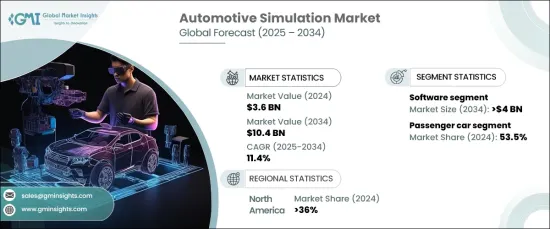
세계의 자동차 시뮬레이션 시장 규모는 2024년에는 36억 달러로 평가되었고 2025년부터 2034년에 걸쳐 CAGR 11.4%로 확대되어 강력한 성장률을 이룰 것으로 예측되고 있습니다. 이 눈부신 성장의 큰 촉진요인이 되고 있는 것이, 전기자동차(EV)나 자율 주행차(AV)에의 급속한 변화입니다. 자동차 산업이 지속 가능한 솔루션과 최첨단 기술을 도입함에 따라 시뮬레이션 툴 수요가 급증하고 있습니다. 이러한 기술은 배터리 시스템, 파워트레인, 충전 인프라와 같은 주요 차량 구성 요소를 최적화하고 보다 정교한 자동차 설계로의 원활한 전환을 촉진하는 데 필수적입니다. 경쟁이 치열해지는 시장에서 한 걸음 더 나아갈 필요가 있기 때문에 시뮬레이션은 개발 프로세스의 필수 요소입니다.

클라우드 기반의 자동차 시뮬레이션 플랫폼은 복잡한 차량 테스트에 필요한 유연성과 확장성을 제조업체에 제공하여 큰 지원을 받고 있습니다. 클라우드 기반 솔루션은 물리적 하드웨어에 대한 고액의 투자를 필요로 하지 않아 기업에 강력한 계산 리소스에 대한 액세스를 제공합니다. 이 시프트는 효율성을 높일 뿐만 아니라 기업이 설계 및 테스트 프로세스를 간소화하고 시간과 비용을 절약할 수 있습니다. 자동차 업계에서는 이러한 디지털 플랫폼에 대한 의존도가 높아져 제조업체는 성능 지표를 개선하고 환경 및 안전 기준에 대한 규정 준수를 향상시킬 수 있습니다.
| 시장 범위 | |
|---|---|
| 시작 연도 | 2024년 |
| 예측 연도 | 2025-2034년 |
| 시작 금액 | 36억 달러 |
| 예측 금액 | 104억 달러 |
| CAGR | 11.4% |
시장은 하드웨어, 소프트웨어, 서비스 등 여러 주요 부문으로 분류됩니다. 2024년에는 소프트웨어 분야가 44%의 점유율로 시장을 선도했고 2034년까지 40억 달러를 창출할 것으로 예측됩니다. 자동차 시뮬레이션 소프트웨어는 엔지니어가 차량 설계를 테스트하고 개선하기 위한 가상 프로토타입 개발에 필수적입니다. 이 소프트웨어는 차량 역학, 공기 역학, 충돌 성능 및 파워트레인 효율을 평가하는 데 중요한 역할을 합니다. 현대 차량은 복잡성을 늘리고 있으며, 특히 EV와 AV 기술이 계속 발전하고 있는 가운데 혁신적인 소프트웨어 솔루션의 필요성이 그 어느 때보다 높아지고 있습니다.
차종별로 시장은 승용차, 상용차, 오프 고속도로 차량으로 나뉩니다. 승용차는 2024년 시장 점유율의 53.5%를 차지했습니다. 이러한 이점은 세계 자동차 생산에서 핵심적인 역할을 하고 있기 때문에 성능, 연비, 공기 역학 및 안전 기능을 최적화하기 위한 시뮬레이션 툴에 대한 수요가 증가하고 있습니다. 이 분야에서 시뮬레이션 기술이 널리 이용되고 있는 것은 자동차 개발의 진화에 있어서 시뮬레이션 기술의 중요성을 부각시키고 있습니다.
지역별로는 북미가 자동차 시뮬레이션 시장에서 가장 큰 점유율을 차지하고 2024년에는 36%를 차지했습니다. 이 지역에는 주요 제조업체와 연구 거점이 있어 자동차 산업이 확립되어 있는 것이 이 우위성의 주요 요인입니다. 북미 기업은 자동차 시뮬레이션 기술을 활용하여 자동차 성능, 안전 기능 및 법규에 대한 대응을 강화하고 있습니다. 이 지역은 혁신을 중시하고 엄격한 규제 기준을 준수하기 때문에 이러한 시뮬레이션 도구의 보급이 진행되고 있습니다. 이러한 동향의 진전에 따라 시장은 향후 10년간 급속히 확대될 것으로 예상됩니다.
The Global Automotive Simulation Market is valued at USD 3.6 billion in 2024 and is set to experience a robust growth rate, expanding at a CAGR of 11.4% from 2025 to 2034. A major driving force behind this impressive growth is the rapid shift towards electric vehicles (EVs) and autonomous vehicles (AVs). As the automotive industry embraces sustainable solutions and cutting-edge technologies, the demand for simulation tools has surged. These technologies are essential for optimizing key vehicle components, such as battery systems, powertrains, and charging infrastructure, facilitating a smooth transition to more advanced automotive designs. The need to stay ahead of the curve in an increasingly competitive market has made simulation an indispensable part of the development process.

Cloud-based automotive simulation platforms have gained significant traction, offering manufacturers the flexibility and scalability required for complex vehicle testing. By eliminating the need for hefty investments in physical hardware, cloud-based solutions provide businesses with access to robust computational resources. This shift not only enhances efficiency but also allows companies to streamline their design and testing processes, saving on time and costs. As the automotive industry increasingly relies on these digital platforms, manufacturers can improve performance metrics and compliance with environmental and safety standards.
| Market Scope | |
|---|---|
| Start Year | 2024 |
| Forecast Year | 2025-2034 |
| Start Value | $3.6 Billion |
| Forecast Value | $10.4 Billion |
| CAGR | 11.4% |
The market is categorized into several key segments, including hardware, software, and services. In 2024, the software segment led the market with a 44% share and is projected to generate USD 4 billion by 2034. Automotive simulation software is vital for developing virtual prototypes that allow engineers to test and refine vehicle designs. This software plays a critical role in assessing vehicle dynamics, aerodynamics, crash performance, and powertrain efficiency. With the growing complexity of modern vehicles, especially as EV and AV technologies continue to evolve, the need for innovative software solutions is more important than ever.
On a vehicle type basis, the market is divided into passenger cars, commercial vehicles, and off-highway vehicles. Passenger cars represented 53.5% of the market share in 2024. This dominance is driven by their central role in global automotive production, leading to a high demand for simulation tools to optimize performance, fuel efficiency, aerodynamics, and safety features. The widespread use of simulation technologies in this segment highlights their significance in the evolving landscape of automotive development.
Regionally, North America held the largest share of the automotive simulation market, accounting for 36% in 2024. The region's well-established automotive industry, with major manufacturers and research hubs, is a key factor in this dominance. Companies in North America are leveraging automotive simulation technologies to enhance vehicle performance, safety features, and regulatory compliance. The region's strong emphasis on innovation, along with adherence to stringent regulatory standards, is driving the widespread adoption of these simulation tools. As these trends continue to develop, the market is expected to expand rapidly over the next decade.